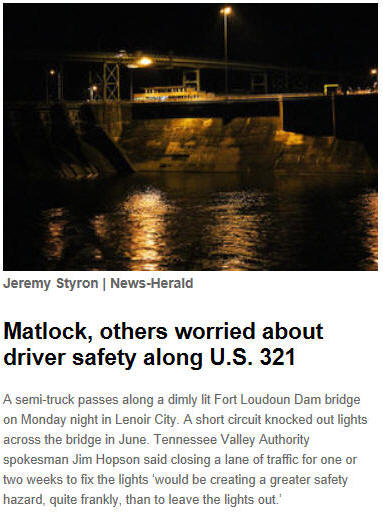 No
street lights along the Fort Loudoun Dam bridge have
some drivers in the community concerned it could pose a
safety hazard during nights and early mornings when
roads have low visibility.
No
street lights along the Fort Loudoun Dam bridge have
some drivers in the community concerned it could pose a
safety hazard during nights and early mornings when
roads have low visibility.Tennessee Valley Authority spokesman Jim Hopson said some lights along the bridge went out in June due to a short circuit.
The short circuit comes after TVA disconnected some lights in November 2012 to make way for the widening of Highway 321. TVA engineers conducted a safety analysis in July to assess the plausibility of repairing the blown circuit. Hopson said engineers determined repairs would have restricted the bridge to one lane for one to two weeks.
“So, it would have been a fairly significant impact on traffic in an area that’s already heavily impacted by the project,” Hopson said. “So, looking at the greater good of the motoring public through there, we felt that it was not wise for us to take that added step when the safety impacts of a lack of those lights were considered so small.”
Hopson said the potential safety hazards were “extraordinarily minimal” compared to limiting traffic to a single lane for at least one week. Closing off one lane “would be creating a greater safety hazard, quite frankly, than to leave the lights out,” he said.
State Rep. Jimmy Matlock, R-Lenoir City, said he has been in discussion with Tennessee Department of Transportation representatives for a little more than a month after receiving about two dozen phone calls from concerned residents in the community. He said he still gets calls regarding the bridge throughout the week.
“Well, if a light goes out in your home, it was obviously put there for a purpose, and you don’t debate whether you put a light bulb back in,” Matlock said. “You just think it was (as) important (as) the day you put it there and nothing has changed. I don’t understand their logic at all. The bridge that we’re building we know is 18 months away from being completed. We know that, and he’s (Hopson) talking about a week’s restriction because of some changes to put the bulbs or new lines up.
“I don’t know how much it would take to correct blowing a fuse or blowing a circuit,” he added. “I’m not an electrician, but I can’t imagine it’d take a whole week to shut one lane down to fix if they simply went out. I mean, I don’t know if they went out on an overload issue or wires were cut, but there’s nothing physically that happened. No poles had fallen; no electrical storms have come through.”
Hopson said drivers should be safe as long as they adhere to the speed limits and caution signs around the bridge.
“If you do that, along with obviously those basic traffic safety rules that we’ve all learned since we began driving in terms of having your low beams on in foggy conditions, making certain that you are not blinding the traffic even outside of foggy conditions, (you should be fine),” Hopson said. “The traffic engineers felt that there was not a significant increase in safety hazards to leave those lights off, again, especially compared to the safety hazard that would be created by further lane restrictions in that area.”
The lights will remain off until the new bridge has been constructed, he said.
TDOT Regional Director of Operations Amanda Snowden said work on the bridge is still scheduled to be completed by June 15, 2016.
“It’s dark as a cave, and then you’ve got two eyeballs (car lights) coming at you,” Matlock said about driving on the bridge in the dark. “I mean, I just don’t get it. It’d be different if the new bridge was going to be ready in three weeks or a month or something. You know, maybe that’s OK to just hold up, but we’re not talking about that. We’re talking 18 to 24 months.”